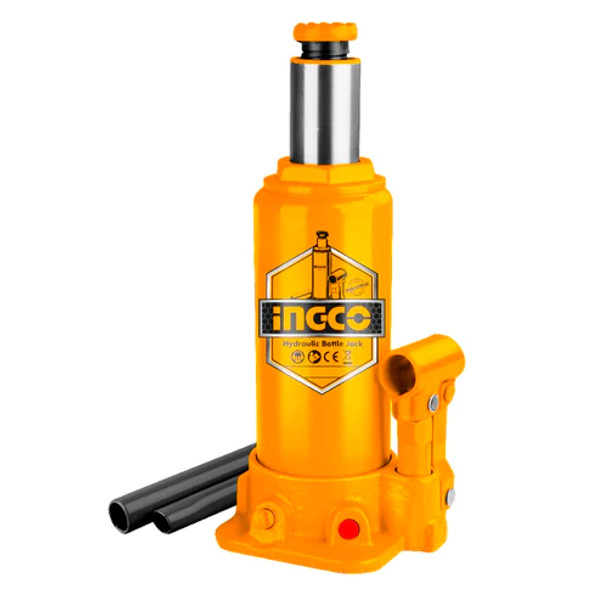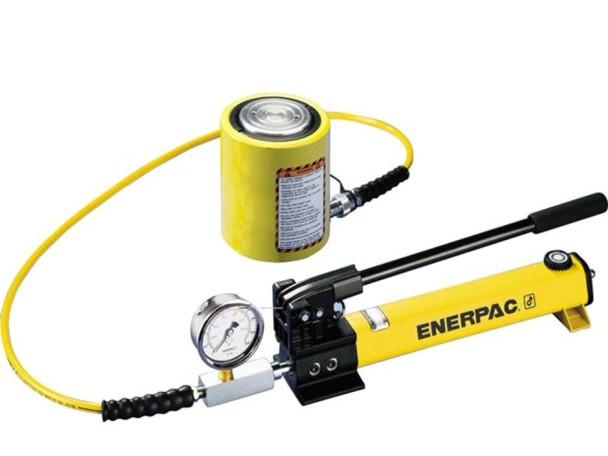Hydraulic Jacks for Automotive Repair: Key Features and Benefits
Key Takeaway
- Essential Tool: Hydraulic jacks are crucial for lifting vehicles during automotive repairs, ensuring safety and efficiency.
- Variety of Types: Options include floor jacks, bottle jacks, scissor jacks with hydraulic assist, and trolley jacks, each suited for different needs.
- Key Features: Lifting capacity, construction material, hydraulic efficiency, safety mechanisms, and portability are vital considerations.
Introduction
Hydraulic jacks are essential tools for automotive repair, providing a safe and efficient way to lift vehicles for maintenance. They come in various types, including bottle jacks, which are compact and powerful, making them ideal for a range of lifting tasks. For heavy-duty applications, the Ingco Hydraulic Bottle Jack 50 Ton HBJ5002 is a robust choice, capable of lifting large trucks and industrial equipment with ease.
For mid-sized vehicles, the Ingco Hydraulic Bottle Jack 20 Ton HBJ2002 offers a perfect balance of strength and versatility. For smaller vehicles or occasional use, the Ingco Hydraulic Bottle Jack 2 Ton HBJ202 is lightweight, portable, and reliable. These jacks are designed with safety and efficiency in mind, featuring sturdy construction, smooth hydraulic systems, and easy operation. Whether you're a professional mechanic or a DIY enthusiast, choosing the right hydraulic jack ensures effective and secure automotive repairs.
Ingco Hydraulic bottle jack 50 Ton HBJ5002
Types of Hydraulic Jacks
Understanding the different types of hydraulic jacks helps you choose the best tool for your needs:
1. Floor Jacks
These jacks have a flat base for stability and are designed for easy maneuverability. They are ideal for lifting cars and SUVs in garages or workshops.
2. Bottle Jacks
Compact and powerful, bottle jacks are cylindrical in shape and can lift heavier vehicles like trucks. Their small size makes them a popular choice for mobile mechanics.
3. Scissor Jacks with Hydraulic Assist
These are lightweight and portable, perfect for emergencies on the road. The hydraulic assist makes them easier to use than manual scissor jacks.
4. Trolley Jacks
These are equipped with wheels for mobility and are commonly used in professional settings due to their stability and ease of operation.
Key Features of Hydraulic Jacks
When selecting a hydraulic jack, consider these essential features:
1. Lifting Capacity
Ensure the jack can handle the weight of your vehicle. Capacities range from 2 tons for smaller cars to over 20 tons for heavy-duty trucks.
2. Construction Material
Steel jacks are durable and sturdy, while aluminum jacks are lighter and easier to transport.
3. Hydraulic System Efficiency
A well-designed hydraulic system ensures smooth lifting and lowering, saving time and effort.
4. Safety Features
Look for features like overload protection, locking mechanisms, and anti-slip handles for safe operation.
5. Portability
Consider the jack’s weight and compactness if you need to transport or store it regularly.
INGCO Hydraulic Floor Jack HFJ201
Benefits of Using Hydraulic Jacks
Hydraulic jacks offer several advantages over traditional lifting tools:
1. Ease of Use: Hydraulic jacks require minimal physical effort, making them ideal for lifting heavy vehicles quickly and efficiently.
2. Versatility: Suitable for a wide range of vehicles, from compact cars to heavy trucks, and adaptable to various repair tasks.
3. Safety and Stability: Designed to provide a stable lift, reducing the risk of accidents during maintenance.
4. Durability: With proper care, hydraulic jacks are long-lasting tools that can withstand repeated use in demanding environments.
Factors to Consider When Choosing a Hydraulic Jack
Choosing the right hydraulic jack depends on several critical factors:
1. Vehicle Type and Weight: Ensure the jack’s lifting capacity matches or exceeds the weight of your vehicle. For example, a 2-ton jack is sufficient for most sedans, while larger vehicles like trucks may require a 4-ton or higher-capacity jack.
2. Lifting Height Requirements: Consider the clearance of your vehicle and the maximum lift height you’ll need for repairs or maintenance tasks.
3. Frequency of Use: For professional use, invest in high-quality, heavy-duty jacks designed to withstand frequent and intensive operation.
4. Operational Environment: Portable jacks are ideal for roadside use, while stable, heavy-duty jacks are better suited for workshops.
5. Budget and Quality: While budget is important, prioritize quality and safety. Opt for trusted brands and models with strong customer reviews and certifications.
Maintenance Tips for Hydraulic Jacks
Proper maintenance is essential for the longevity and performance of your hydraulic jack:
1. Check Hydraulic Fluid Levels: Regularly inspect and top off hydraulic fluid to maintain smooth operation. Low fluid levels can reduce lifting efficiency.
2. Inspect for Leaks: Look for oil leaks around the hydraulic system, as they can compromise the jack’s functionality.
3. Clean Moving Parts: Dirt and debris can hinder performance, so clean the jack’s components regularly and lubricate moving parts as needed.
4. Store Properly: Keep the jack in a dry, clean area to prevent rust and corrosion. Avoid exposing it to extreme temperatures.
5. Inspect Before Use: Always check for signs of wear, damage, or malfunction before operating the jack. Replace worn-out parts promptly.
Safety Tips When Using Hydraulic Jacks
To ensure safety during automotive repairs, follow these precautions:
1. Use on Level Surfaces: Always position the jack on a stable, flat surface to prevent tipping.
2. Do Not Overload: Never exceed the jack’s rated capacity, as this can cause failure and accidents.
3. Support with Jack Stands: Hydraulic jacks are designed for lifting, not long-term support. Always use jack stands to stabilize the vehicle before working underneath it.
4. Follow Manufacturer Guidelines: Adhere to the instructions provided by the jack’s manufacturer to ensure safe operation.
5. Stay Clear of the Jack’s Range: Avoid standing or placing any part of your body under the vehicle while it is supported by the jack alone.
Ingco Hydraulic bottle jack 20 Ton HBJ2002
Top Hydraulic Jacks for Automotive Repair
1. Ingco Hydraulic bottle jack 50 Ton HBJ5002: Known for its durability and smooth lifting mechanism, ideal for workshop use.
2. Ingco Hydraulic bottle jack 20 Ton HBJ2002: Compact and powerful, capable of lifting heavy trucks with ease.
3. INGCO Hydraulic bottle jack 2Ton (HBJ202): Lightweight and portable, perfect for small cars and emergency roadside repairs.
Common Challenges When Using Hydraulic Jacks
Even with high-quality hydraulic jacks, certain challenges can arise:
1. Hydraulic Fluid Leaks: Leaks can result in reduced lifting power. Regularly inspect seals and replace worn-out parts to prevent this issue.
2. Overloading the Jack: Exceeding the jack's rated capacity can cause mechanical failure. Always check the vehicle’s weight and choose an appropriate jack.
3. Improper Maintenance: Neglecting to clean or lubricate the jack can lead to reduced efficiency and a shorter lifespan. Maintain a regular care routine.
4. Using on Uneven Surfaces: Attempting to use a jack on uneven or sloped surfaces increases the risk of instability. Always ensure the ground is flat and stable.
5. Lack of Jack Stands: Relying solely on the hydraulic jack for support during repairs can be dangerous. Always use jack stands for safety.
ENERPAC 50 Ton, Hydraulic Cylinder and Hand Pump Set
Frequently Asked Questions
1. What is the maximum weight a hydraulic jack can lift?
Hydraulic jacks are available with varying lifting capacities, typically ranging from 2 tons to over 20 tons. Choose one that suits your vehicle’s weight.
2. How often should I check the hydraulic fluid in my jack?
It's recommended to inspect hydraulic fluid levels every 3–6 months or after extensive use. Top off or replace the fluid as necessary.
3. Can I use a hydraulic jack on a gravel surface?
It’s not recommended. For safety, always use the jack on a flat, solid surface. Use a wooden or metal plate as a base if no alternative surface is available.
4. How do I know if my hydraulic jack needs repair?
Signs include slow lifting, difficulty lowering, hydraulic fluid leaks, or strange noises during operation. Address these issues promptly to ensure safety.
5. What’s the difference between a bottle jack and a floor jack?
Bottle jacks are compact and have higher lifting capacities, making them suitable for trucks and SUVs. Floor jacks are more stable and easier to maneuver, ideal for low-clearance vehicles.
Related Articles
Hydraulic Jack vs. Mechanical Jack: Which is Better?
Readers also Watched...
Conclusion
Hydraulic jacks are vital tools for automotive repair, offering efficiency, versatility, and enhanced safety. By selecting the right type of jack and maintaining it properly, you can ensure reliable performance and longevity. Whether for professional workshops or personal use, investing in a quality hydraulic jack pays off in convenience and safety.
For premium hydraulic jacks and accessories, visit GZ Industrial Supplies. Explore a wide range of high-performance jacks designed to meet your automotive repair needs. Shop now for quality products and expert support!
Recent Posts
-
What is the Difference Between 11KV and 33KV Power Transformer Lines?
Introduction As an electrical engineer or utility professional, you likely handle a variet …Apr 10, 2025 -
Top 10 Industrial Hubs in Nigeria: A Guide for Suppliers and Manufacturers
Introduction Nigeria, Africa's largest economy, boasts a diverse and rapidly growing industrial …Apr 10, 2025 -
Which Generator is Best for Home use in Nigeria 2025
Unstable power supply is a reality many Nigerian households contend with daily. Whether it&rsqu …Apr 09, 2025










